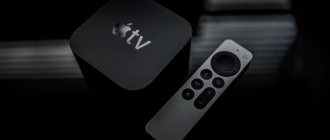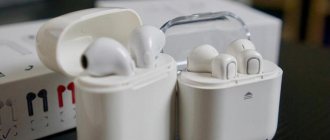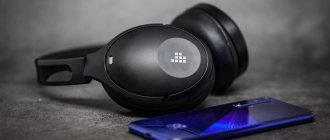When Apple introduced the first wireless headphones AirPods three years ago, there were still some doubts about their future success, but now it is impossible to deny that despite the relatively high price and obvious connection to the Apple ecosystem, AirPods have taken root. All you have to do is go outside or take the subway to see for yourself. However, the metro is not the best example. AirPods are a convenient thing, but the lack of active noise cancellation greatly limits them. And the very design of in-ear headphones, although extremely democratic and suitable for most users, has its own, essentially irremovable, flaws in sound transmission. Isolating headphones with active noise cancellation have become a natural step forward.
But Apple wouldn’t be Apple if it released just another wireless headset with noise cancellation, like similar products from competitors that also took the original AirPods as a basis. There are many sophisticated and sometimes surprisingly effective technical solutions used here. Let's figure out why the new product is so good and thoroughly check the sound quality, without any concessions to the compact form factor. After all, whatever one may say, the “professional” version of AirPods has become significantly more expensive: the Russian Apple website sells them for 20,990 rubles, which is 4 thousand rubles more than standard AirPods with contactless charging and 7,500 with wired charging. .
⇡#Design and construction
The AirPods still look very distinctive. Snow-white glossy surface, drop-shaped shape and protruding stems - the design features of the first two models remained in place. However, Pro has obvious differences from its ancestors. The body of each headphone has swelled a little and become heavier to accommodate the updated internal components (and, by the way, a battery with an increased service life), and the appendages, on the contrary, have become shorter. As a result, the AirPods Pro aren't as eye-catching as a pair of older headphones that were nicknamed "cigarette butts" by Apple's anti-Apple crowd. It's just a shame that the company still doesn't offer several color options in addition to the standard white.
But these are all minor things. The most important thing about AirPods Pro is, of course, the isolating mechanics with active noise reduction, for which the entire design of the sound path is tailored. The acoustics of previous models develop the ideas laid down in the standard wired EarPods, which Apple puts in the box with every iPhone (but, they say, will also replace them with wireless ones in the future). In EarPods and older AirPods, sound enters through two holes, one of which is aimed deep into the ear, and the second - forward so that the wave is reflected from the curve of the ear. The latter is important in order to create a comprehensive sound stage, which cannot exist without the participation of the auricle. And the grille on the back side of the speaker allows the membrane to vibrate freely and thereby reproduce low frequencies better (as far as possible in principle with such dimensions and open design).
AirPods Pro are designed completely differently. The only source of sound is the grille, directed directly into the ear canal, while the silicone ring guarantees a reliable grip. In the box with the headphones there are two pairs of earbuds of different sizes, and the third - medium size - was put on in advance. Standard silicone tips for isolating headphones will not fit the new Apple product: you need a different diameter and its own, elliptical shape of the hole (fortunately, replacements are sold for $4). Branded earbuds do not penetrate the ears as deeply as regular ones (not to mention in-ear models with a long “sting”), and the gadget itself is also held in place by the protrusion of the auricle. In addition, AirPods Pro are not strictly isolating headphones. The body of the droplets has vents that partially allow air between the eardrum and the outside world. This, at first glance, is a rather strange solution, but as a result, the feeling of pressure on the eardrums, characteristic of conventional headphones, disappears.
Thanks to their “non-invasive” design, AirPods Pro fit so comfortably in your ears that they seem easy to lose. It’s not for nothing that Apple came up with a special test to check insulation. If you select the appropriate command in the Bluetooth menu on the iPhone, a tune will play for five seconds, and then the system will decide whether the pads are the right size or if you need to try a different pair. The entire procedure is fully automated thanks to a separate microphone directed into the ear canal. Yes, yes, AirPods Pro have an internal microphone, and not only for trying on tips - but more on that later.
As a result, if you put on the correct size earbuds, the headphones will not fall out even while running. Although, of course, in the crowded metro it is better to protect yourself with a hood or hat. But keep in mind that the main voice microphone on the AirPods Pro has moved from the tip of the device to a larger grille higher up on the body. Apple says that in addition to the background noise filtering and beamforming features that have been present in AirPods since the beginning, the grille protects the microphone from wind gusts. The headphones themselves are now protected from moisture according to the IPX4 standard. This means that the gadget resists splashes of water from any side of the case, and with AirPods Pro in your ears you can easily run in the rain. Swimming and diving are no longer worth it, although some owners' previous models remained alive even after a full cycle in the washing machine.
Photo by iFixit
The body of each headphone accommodates a battery of increased capacity - 160 mWh instead of the previous 93. By the way, this is a completely standard button battery of the 1154 format, but still you are unlikely to change it without the help of a service center. The extended energy ration was mostly consumed by the new filling of the gadget, but some was left for the user to share. Apple promises the same five hours of listening to music at 50% volume (half an hour less with noise cancellation), but talk time has increased from three hours for AirPods 2 to three and a half. However, this is a very conservative estimate: we, for example, got more than 5 hours of music even with active noise reduction. To quickly extend the work by one hour, just five minutes of charging is enough.
The box in which the AirPods Pro are stored has also grown to match the headphones themselves. Inside it are hidden two more batteries of solid capacity - 1.98 Wh each (AirPods 2 had enough of one for 1.52 Wh), and a full charge of the entire set guarantees 24 hours of sound or 18 hours of voice communication. The case itself is powered via the Lightning connector, but Apple is gradually moving its devices to USB Type-C, so this connector has grown at the other end of the included AirPods Pro cable. There is also the possibility of wireless charging from any Qi standard station. A dot RGB LED on the side of the container shows the current energy level: red means charging is in progress, green means it can be removed. If you press the button that starts the pairing process via the Bluetooth interface, the dot lights up white, although it is not useful for communicating with modern Apple gadgets.
Binding and Control
To connect AirPods Pro to an iPhone, you need to open the container with the headphones next to it and allow the connection in the pop-up window - the gadgets will negotiate the rest on their own via the BLE (Bluetooth Low Energy) channel. All user devices authorized under one Apple ID - Mac, iPad, Apple Watch, Apple TV, etc. — they are connected to the headphones instantly, and there is no need to repeat the pairing procedure for each of them. However, quick pairing is only possible when interacting with an iPhone no older than the sixth model or SE, and iPad support begins with Mini 4. AirPods Pro may well work with products from other manufacturers or outdated Apple technology (tested on the very first iPad with Bluetooth 2.1 on board), but like a regular headset without fancy software features.
Compatible devices running iOS and iPadOS instantly redirect sound to AirPods Pro as soon as they are in the owner’s ears (for this purpose, there are infrared sensors on the bodies of the droplets). If you start listening to music and remove one earphone, playback will pause, and if you remove both, the sound source will change back to the built-in speaker. For a conversation, you can use the headphones alternately to save battery power - only the one in the owner’s ear always works. But this functionality is not fully available to old iPhones, Androids and any other systems. The first connection must be made manually, and the sensors do not respond to the human body. A partial exception is macOS, where the AirPods Pro charging case acts as a switch. Just open the lid and AirPods Pro immediately appear in the audio source menu, and if you return them to charge, they will automatically disconnect. The proximity sensors also work, but for some reason the headphones separately do not (to turn one off, you need to put it on charge).
Apple's previous wireless models have a similar set of features and limitations, but the Pro has changed a lot. There are no buttons on any AirPods, and previously they used built-in accelerometers for control, and, frankly, it wasn't very convenient. Regular AirPods respond to a light double swipe of your finger on the earbud, which issues a play/pause command or hangs up during a call. Moreover, you need to knock confidently, otherwise there will be no reaction. AirPods 2 have learned to call the voice assistant Siri, but, no matter how you look at it, in order to quickly perform even such trivial actions as scrolling through a playlist, every now and then you have to take your smartphone out of your pocket.
AirPods Pro respond to pressure instead of tapping. Squeezing the earbud stem once is a play/pause signal, twice is forward through the music playlist, and three times is backward. A long press turns the noise reduction function on and off, or, if you check the appropriate box in the settings (and for each headphone separately), calls up Siri - of course, only on Apple devices. In response to the command, the headphones make a quiet click. So, you see, it’s much better. In addition, the pressure sensor is active regardless of the operating system in conjunction with any device - no matter iOS or Android. The only thing that owners of Android smartphones who bought a product from someone else’s ecosystem are deprived of is the separate operation of two headphones and other useful automation tied to the infrared sensors of AirPods and the Bluetooth Low Energy interface. However, you also need to get used to the sign language that AirPods Pro understands, and to change the volume, you still have to call Siri for help or turn the crown of the Apple Watch. By the way, the watch communicates directly with AirPods, so taking a smartphone with you to listen to music while walking or jogging (and in those countries where there is eSIM and models with LTE are sold - and answering calls) is not at all necessary.
Advantages of Apple AirPods
Secure fit. You don't have to worry about how they fit in your ears.
The completely wireless design of AirPods has many people worried about whether these headphones will stay securely in their ears and whether they are at risk of falling out with sudden movements.
Apple engineers designed the weight and design of AirPods so you don't have to worry about the fit. I managed to sneeze a couple of times, run up a few flights of stairs, ride in a crowded subway car, shake my head a lot, and walk for half an hour without having to put the AirPods back in place or adjust them in my ear. The fit is absolutely comfortable and secure. Audio quality.
A sound that suits millions of people around the world. Bang & Olufsen, AKG, Astell&Kern, Bose - headphones from these and a dozen other premium manufacturers sound better than those from Apple. However, is it possible to compare a product for 12,990 rubles with headphones, whose cost can easily exceed the price of the top version of the iPhone? In the audio segment, Apple has never set itself the goal of competing with audiophile models of players or headphones, but they have always released the most popular, sought-after and desired products. Most iPhone owners are completely satisfied with the included headphones, so much so that many of them buy the same EarPods to replace lost or broken ones. AirPods are no exception - these headphones have high-quality sound to satisfy the vast majority of owners of Apple equipment. Their owners will hear the already familiar and beloved sound, further improved by new technologies and a special W1 processor.
You are unlikely to lose them. It's time to debunk one of the most popular misconceptions about AirPods.
Since you've probably never had anything quite like AirPods, these headphones create new use cases. While after use we most often simply throw a regular headset into a bag, hide it in a pocket or put it on a shelf, AirPods immediately set the owner up for constant use of the case. Firstly, thanks to this they will always be charged, secondly, you won’t have to dig around in your bag looking for a second earphone, and thirdly, pets won’t mistake them for a new toy. When using a case, the risk of losing AirPods tends to zero, and storing headphones without it will immediately seem to you not the most convenient and reasonable solution.
⇡#Noise reduction
The signature feature of the AirPods Pro is, of course, active noise cancellation, which was so lacking in previous AirPods models. It operates on the same principle as any other speaker system, creating a sound wave out of phase with unwanted sounds, but Apple's implementation, as always, is particularly sophisticated. We have already noticed that each earbud has two microphones, one of which is directed inward. The AirPods Pro electronics poll it at a frequency of 200 times per second, checking what sounds have gotten inside from the outside world, and adjusting the noise reduction accordingly. Apple says there are no other headphones with similar technology.
Be that as it may, the system works, and is quite effective: constant, predictable noise - like, for example, on an airplane or train - if it does not disappear completely, it becomes almost inaudible. However, active noise reduction is not all-powerful: irregular background sounds are clearly noticeable, although, for example, the conversation of people around turns into a quiet whisper. The rumble of the subway also cannot be completely removed - only in-ear headphones screwed deep into the ear holes can save you from this. But there is no uncomfortable feeling like the air has been sucked out of your ears, which often occurs with other headsets. Noise cancellation is turned on by default as soon as the earbuds are tethered to your phone, and unless you can see in the settings menu that it actually works, it's easy to think that the AirPods Pro are just well-insulated (they're actually partially breathable). At the same time, in complete silence you can hear the AirPods Pro in active mode making a barely audible hiss, but who needs to deal with external noise in silence?
There is no manual adjustment of active noise cancellation, which many AirPods Pro analogues have acquired, here, everything is done automatically. But there is another impressive feature: the “pass-through” mode, when the headphones do not attenuate background noise, but, on the contrary, transmit inside everything that the external microphone hears. Silicone gaskets dampen the sounds of the outside world, and sometimes this is completely unnecessary. Apple is not a pioneer here—headphones from other companies have a similar option. The important thing is that “transparency” works surprisingly naturally and imperceptibly (here again I had to make sure in the menu that the function was really turned on), absolutely without delay, and everything that happens outside is perfectly audible, as if you weren’t wearing AirPods Pro in your ears. and simple AirPods or wired Apple headphones. Only the sound in the mid-frequency range, corresponding to human speech, is slightly adjusted by the automation - apparently, this is intended. You can switch the headphones between three modes—passive, noise-canceling, and “permeable”—using a pressure-sensitive sensor or in the Apple operating system menu.
Wireless charging - not everything is so smooth
I used a Belkin wireless station that I bought from the Apple Store two years ago. This is an accessory officially recommended by the manufacturer. At least, its presence in the company store seems to hint at this. What is this for? Now you will understand everything.
Unfortunately, you can’t just put the case with AirPods on it and forget about it. Every now and then the charging process is interrupted. The LED indicator on the front side of the AirPods only lights up for the first minute. Then it goes out, which in theory should mean that charging has stopped. There is an operation indicator on the station itself, but it also behaves like a crazy girl. It may burn all the time, or maybe only the first couple of minutes. I tried placing the case in the center, closer to the rubberized edge - it was no use, charging worked unpredictably.
Now the new Belkin BOOST UP Special Edition station is being sold on the company’s website. The issue price is 8,431 rubles. Perhaps there won't be such problems with her.
In any case, the charging case still started. In 45 minutes, only the headphones were charged; the remaining hour and a half, only the case was charged. This is a very long time, so it makes sense to put the “pods” on the station all night at once.
As soon as I get another wireless station, I will immediately test it along with the case from the second generation. And then I will supplement the review with fresh data.
⇡#Compatibility considerations
The pro version of AirPods has turned from a hipster accessory for dedicated Apple fans, the purpose of which is to untie headphones from wires, into a completely universal headset with a full set of modern functions. And if the sound quality doesn’t let you down (we’ll see this soon), then it will be a tempting and somewhat unique offer not only for iPhone owners, but also for those who don’t have a single Apple device. But with this, alas, everything is far from being as simple as we would like.
The headset provides the best (or at least predictably high-quality) sound when playing music in conjunction with Apple technology due to purely software reasons. AirPods Pro receive audio over Bluetooth using the standard A2DP profile, which has enough bandwidth to transmit high bitrate data (up to 500 Kbps). But the compression formats themselves are completely different. Apple prefers its own AAC codec, which, for example, stores the entire iTunes music library. If the communication channel and bitrate allow, the AAC stream from Apple devices is sent to AirPods Pro without intermediate transcoding (iTunes 256 Kbps recordings are definitely direct, but AAC Lossless is no longer). But many Android smartphones will have to convert the sound for AirPods Pro to the SBC format - the bitrate in the latter can also be quite high (328 Kbps), but the quality is obviously inferior to AAC. It should be noted that Google introduced direct support for the Apple codec into Android quite a long time ago, but whether it is used or not needs to be checked separately. And if yes, then this is not a guarantee of high-quality sound.
The fact is that AAC is a very demanding format in terms of processing power due to the fact that it is the only codec in Bluetooth that implements psychoacoustic compression principles. Apple's SoCs and the H1 processor in AirPods Pro process it in the hardware and can afford resource-intensive encoding algorithms. In Android smartphones with AAC support, the situation is most often exactly the opposite, and the sound can easily turn out to be worse than when using the consumer-grade SBC codec. On the other hand, the AirPods Pro themselves cannot work with the high-quality proprietary aptX and LDAC codecs owned by Qualcomm and Sony. In the end, whether AirPods Pro will make friends with Android depends entirely on the specifics of the particular device. It’s better not to include AAC out of harm’s way and limit yourself to SBC - for picky listeners it’s not so bad.
There is another slippery point: AirPods Pro and modern Apple gadgets (starting with the iPhone 7) are capable of transmitting and receiving a Bluetooth signal at the Class 1 power level, due to which the connection with the headset penetrates through concrete walls and does not break at a distance of several tens of meters. Otherwise, the connection falls into low-power Class 2, the range of which does not exceed tens of meters.
Functionality
The manufacturer announced 11 functions available when controlling the headset. For control, a standard remote control is used, which has only three keys.
But each of them is assigned several tasks at once:
- one press in the middle – pause, turn on music, answer an incoming call while playing melodies, answer a second incoming call;
- double pressing – switches to the next track, if you hold after pressing – rewinds;
- triple press – switch to the previous melody, if held – rewind;
- press and hold the key - call Siri, hang up the incoming call, answer the second incoming call and hang up the first;
- increase/decrease volume using the “+” and “-” keys.
The standard volume keys are also programmed with other functions. For example, by long pressing the “+” key, you can open the camera on your phone and take a photo of the desired object without unlocking your smartphone.
With Android smartphones, the number of functions is significantly reduced. You can answer the call, pause the music and start playing again. You can also adjust the volume using the side keys. In principle, these functions are sufficient for ordinary headphones, but not for a device costing 2,500 rubles.
6 Best Lightning Headphones (Lightning Headphones)
⇡#Sound quality
To evaluate the sound in AirPods Pro, we again resorted to the standardized subjective FSQ (Fast Sound Quality) methodology, developed in 2001 by the Acoustic Center of the Department of Broadcasting and Electroacoustics of the Moscow Technical University of Communications and Informatics (MTUCI). FSQ was developed to evaluate automotive acoustics as an alternative to the common IASCA (International Auto Sound Challenge Association) methodology and was subsequently adopted by the international AES (Audio Engineering Society). Quite quickly, FSQ began to be used in testing home (“hi-fi” and multimedia) speaker systems.
Those wishing to test their own speakers or headphones are advised to download the “Audio Doctor FSQ” disk and testing instructions from the MTUSI Acoustic Center page, because the main advantage of this method is clear evaluation criteria that partly compensate for its subjective nature. In most tests, the expert only needs to answer whether the sounds that should be in the recording are heard, or, conversely, those that should not be there.
The FSQ method in its standard version includes 14 test tracks, which evaluate the following characteristics of the speaker system:
- sound path margin for undistorted volume level;
- correct phasing of audio equipment;
- the presence of extraneous sounds, noise and interference in the audio path;
- the ability of the audio path to reproduce the lowest sound frequencies;
- uneven frequency response of the audio path;
- linearity of the stereo image across the width of the sound stage;
- microdynamics and separation of the sound stage in depth;
- position and focusing of the stereo image in the horizontal and vertical planes and the naturalness of the transmission of the musical attack;
- musical and timbral balance of the sound of musical instruments and vocals;
- linearity of the sound picture in terms of volume level and macrodynamics.
We will sequentially list the results of listening to FSQ test recordings on three models of Apple headphones - wired EarPods, first-generation wireless AirPods and AirPods Pro. Each test is accompanied by a brief description from the instructions for the “FSQ Audio Doctor”. Test recordings were pre-converted from WAV to Apple Lossless (ALAC) format and played on a MacBook Pro running macOS 10.15.1.
| Track number | Test Description | Apple EarPods | Apple AirPods | Apple AirPods Pro |
| 1 | Undistorted volume reserve Magic Pump, “Open The Door” RDM, CD RDM 801201, “Ours in the City” The undistorted volume level is determined by the first track of the test disc. It plays a musical fragment where the vocal and bass parts are additionally compressed. The volume level is increased from zero until overload begins, when non-linear distortions begin to be clearly heard on the bass and vocals, perceived audibly as wheezing. | All three Apple models are capable of playing music at maximum volume without noticeable distortion | ||
| 2–4 | Phasing of the audio path between channels Speaker's voice in phase/antiphase, midrange (300–3,000 Hz), high frequency (5,000–22,500 Hz), low frequency (10–150 Hz) The announcer's voice is recorded on the track with the words: “Mid frequencies. Phase". These words should be heard from the center of the sound stage. Then the announcer says: “Mid frequencies. Antiphase." In this case, the announcer's text should be played at a lower volume level and (or) defocused for the listener and (or) shifted to one side or another from the center. The phasing is checked in the same way in the HF band and in the LF band. | The wired Apple headset and AirPods of the first model do not have obvious problems with phase matching, although in the low frequency range the sound “in phase” is not localized as clearly as it should | In AirPods Pro, the phases are perfectly matched throughout the entire frequency range. It is clearly noticeable that sounds in phase are reproduced focused and loud, while sounds in antiphase are played out of focus, to the sides of the center of the sound stage | |
| 5–6 | Presence of interference, rattling, extraneous sounds and noise in the audio path Sliding tone, left/right channel (20-15,000 Hz) A tonal (sinusoidal) signal whose frequency smoothly changes from the lowest to the highest frequencies. Separately, first for the left and then for the right channels | In the lowest frequencies, a quiet “rustle”, on the verge of discrimination, is noticeable. The rest of the range is free from overtones up to the highest frequencies | On the right and left earphones, quiet non-rhythmic clicks are clearly audible in the low frequencies, the mid frequencies are clear, and in a separate section of very high frequencies there is a quiet noise | In the lowest frequencies there is a noticeable “rustle” on the verge of discrimination. A short and very quiet “crunch” appeared in the high-frequency zone of the right and left channels when listening to the track for the first time, but it did not appear again |
| 7 | A set of frequencies for checking the low-frequency path The phonogram, first for the left and then for the right channels, contains a recording of a number of fixed sound frequencies in the low-frequency range. First, the announcer announces that the reference frequency is 60 Hz. The announcer then announces: “20 Hz”, “25 Hz”, “30 Hz” and so on. The first pure low-frequency tone (without distortion and turbulent sip), which coincides in volume with the reference one, determines the lowest operating frequency of the audio path. Ideally, the volume of the remaining tones up to 150 Hz should be the same | Bass is audible starting at 25 Hz. However, frequencies acquire subjectively equal loudness when a jump occurs in the phonogram from 80 to 125 Hz. Up to 125 Hz the sound is very quiet. All low frequencies are accompanied by a very quiet mid-high frequency ringing | In AirPods, bass can be heard starting at 20 Hz. There is the same jump in volume between frequencies of 80 and 125 Hz, however, even up to 125 Hz the bass is heard much louder than in EarPods. At all test frequencies, with the exception of 65 Hz, there is a quiet but clearly noticeable pulsating noise, turning at a frequency of 150 Hz into a barely noticeable high-frequency rustle | Bass is audible starting at a frequency of 20 Hz, and very well. And sounds acquire subjectively equal volume starting from 50 to 80 Hz. At around 125 Hz there is a sharp rise in volume. All low frequencies are accompanied by a quiet but pronounced mid-high frequency ringing |
| 8 | Unevenness of frequency response in the region of medium sound frequencies The phonogram is a high-quality stereo recording of the applause of a large number of spectators in the hall. Clapping your hands in a fairly echoey room is equivalent to a diffuse field—noise—evenly distributed across the spectrum. However, against the background of this monotonous noise, the human ear manages to distinguish the very beginning of the pops (bursts). On an audio path with a linear frequency response, you really hear applause, but if it is uneven (“fence”), it becomes similar to the noise of pouring rain | In headphones of both models, the recording is recognized as applause, not rain. But in EarPods the bulk of the clapping still merges into a single background, but in AirPods it does not | Without noise reduction, it is simply impossible to confuse the clapping of your hands with raindrops. But when noise cancellation is turned on, the sound attack of each clap is partially blurred | |
| 9 | Linearity of stereo image across sound stage width Moving Drum, IASCA Competition CD The phonogram contains seven drum beats, smoothly moving from left to right across the entire width of the stereo image. The impacts are precisely localized in direction, and their movement in space is linear, i.e. the angles between the impacts are the same | In headphones of both models, sound sources are equally well positioned horizontally | Drum hits are perfectly positioned horizontally when noise canceling is turned off. Otherwise, the position of the sound in the right half of the scene is somewhat blurry | |
| 10 | Microdynamics and sound stage depth Alex Rostotsky Trio, “Intro”, POPE Musik PM1014-2, “Boiled Borsht” The phonogram is a small musical fragment with two instruments - a double bass and a drum set. Both musicians are at the back of the stage. Sound stage depth is considered unacceptable if the musicians are visually in the foreground. With unsatisfactory microdynamics, quiet hits on drums and cymbals cannot be heard, and bowing on the double bass is difficult to distinguish. Microdynamics can be considered satisfactory if the drums, cymbals and double bass are audible, but in the sound of the double bass you can’t hear the musician’s fingers tapping on the fingerboard and (or) when the double bass player plays with a bow, you clearly don’t hear the “resting” movement of the bow along the strings. And the microdynamics will be good if the double bass player’s fingers are heard clearly and clearly. The sound path has excellent microdynamics if a very quiet rustling is heard when the drummer accidentally touches the cymbal with his elbow and immediately clamps it with his hand | In the headphones of both models, you can hear finger strikes on the fretboard, and even an accidental touch of the cymbal with the drummer's elbow. However, in AirPods these sounds are louder, and the friction of the bow on the strings of the double bass is more distinct. Headphones of this type cannot fully convey the depth of the scene, but EarPods and AirPods at least placed musical instruments in the background, and not entirely inside the listener’s head | Finger strikes on the fretboard, bow rubbing and accidental contact with the drummer's cymbal are all heard much better than in previous models. But due to the partially isolated design, the concept of “scene depth” does not apply well to AirPods Pro | |
| 11 | Naturalness in sound transmission of musical attack, position and focusing of the sound stage in width and height Ron Tutt, "Improvisation", Sheffield Lab CD-14/20 The soundtrack shows a fragment of a drum solo. An unacceptable transmission of attack is considered if the sound of the drums is dull, there is no elasticity and “meatiness”; unacceptable - if the sound of the drums is quite dynamic, but has an element of “cardboard” in the beat. It is considered unacceptable or less acceptable if the sound stage is narrower than the space between the sound sources. Unacceptable or less acceptable if the cymbals and hi-hat are at the same height or the difference is negligible | Compared to EarPods, the transmission of attack and timbre of drums in AirPods is already at a completely different level. However, in both EarPods and AirPods there is virtually no height positioning of musical instruments, but there is at least a sense of the width of the stage extending beyond the listener’s head | The attack and tone of the drums in the standard AirPods cannot be compared to the sound of the AirPods Pro. But the positioning of musical instruments in height is still very weak, and in addition to this, the stage has become subjectively narrower, as if the instruments are right next to the listener’s head | |
| 12 | Timbral and musical sound balance Mighty Sam McClain, "Give It Up To Love", Audioquest, XRCD, "Got To Have Your Love" The soundtrack is a fragment of a jazz piece with male vocals. It is considered unacceptable or hardly acceptable from the point of view of timbre balance if any of the instruments sounds unnatural and (or) if the vocal timbre is harsh or unpleasant. It is considered unacceptable or less acceptable if the vocals or any of the musical instruments clearly stand out in terms of volume - pushed forward or pushed back | The headphones are very similar in timbre transmission: the sound is “bright” and even harsh due to the accentuated mid-high and high frequencies. In AirPods, this feature is slightly more pronounced than in EarPods, but it is compensated by relatively deep bass | The sound of the AirPods Pro has clearly softened and lost its excess harshness, not to mention the fact that full bass has appeared. All musical instruments are well balanced in volume level. And yet the sound of the headphones is still perceived as “bright” and “edgy” | |
| 13 | Linearity of the sound path in terms of volume level, its macrodynamics and ability to transmit a polyphonic sound image A. Schnitke, “Childhood”, Gorenstein/RSO, POPE Musik, PM 1007-2 1996, “Gogol Suite” The phonogram contains a high-quality recording of a symphony orchestra, performed in the Great Hall of the Moscow Conservatory. The fragment consists of four main parts, differing from each other in volume level and dynamics. It is considered unacceptable or less acceptable if the string pizzicato in the first part is completely unintelligible or sounds too quiet, sluggish and indistinct in comparison with the next, louder part. It is considered unacceptable or hardly acceptable if in the third movement (after the entry of the group of cellos and double basses) there is no noticeable jump in volume and then, in the final, another jump. It can be considered unacceptable or hardly acceptable when non-linear distortions are clearly audible in the third and fourth parts of the phonogram, or when there is no distortion, but the orchestra clearly does not reach forte fortissimo in volume. It is unacceptable if the orchestra already in the third movement begins to sound like a general “mess”, individual groups of musical instruments are poorly distinguishable or completely indistinguishable | Compared to EarPods, AirPods are louder and more articulate in the first, quiet part of the soundtrack and provide a more noticeable transition to the final, loud parts. However, the difference between forte and fortissimo in both models is not as pronounced as it should ideally be. AirPods clearly separate groups of instruments and individual instruments within them in the rich polyphonic portion of the recording. In EarPods the picture is noticeably blurry | The transition in volume from one part of a piece to another is better expressed in AirPods Pro than in previous models, although they still cannot fully convey the difference between the third and fourth parts, which should ideally be the case. Individual instruments and their groups sound quite intelligible | |
| 14 | Additional track for assessing the sound quality of the lowest sound frequencies Guiseppe Verdi, "La Donna E Mobile", Telarc CD-80447 The phonogram contains a nine-second excerpt of the sound of a symphony orchestra, which includes a large (Turkish) drum with a very low register. It can only be heard with a high-quality subwoofer that naturally reproduces frequencies of 20–25 Hz | The bass drum can be heard in both headphone models, but the sound is extremely quiet | You don't have to listen closely to the recording to notice the bass drum - it's not loud, but it's clearly present in the scene. | |
Rating of TOP 8 best models
| Place | Name | Price |
| TOP 8 best Apple headphones | ||
| 1 | Apple AirPods 2 (with charging case) MV7N2 | 9 000 ₽ |
| 2 | Apple AirPods 2 (with Wireless Charging Case) MRXJ2 | 12 000 ₽ |
| 3 | Apple AirPods Color | 11 000 ₽ |
| 4 | Apple EarPods (Lightning) | 2 000 ₽ |
| 5 | Apple AirPods | 9 000 ₽ |
| 6 | Apple AirPods Pro | 16 000 ₽ |
| 7 | Apple EarPods (3.5 mm) | 2 000 ₽ |
| 8 | Apple AirPods 2 Color | 11 000 ₽ |
⇡#Conclusions
AirPods of the first model at one time impressed with their ease of use, communication distance and battery life. But in two years, the charm has dissipated, the public is demanding new features and high-quality sound, and Apple's competitors, who have adopted the AirPods approach, are already ready to provide both. However, the new AirPods are not called Pro for nothing. They now have everything that was sorely lacking in the first two models. Active noise cancellation works flawlessly, and most importantly, does not put pressure on the eardrums. The “transparency” mode - essentially the opposite function - conveys the sounds of the surrounding world in an amazingly natural way, when that’s exactly what you need.
The sound of AirPods Pro, thanks to the semi-closed design, has become better in all respects: excellent dynamics, neutral timbre, but most importantly, it has lost the sharpness that not everyone liked in the original AirPods, and full-fledged low frequencies have appeared (although among isolating or, especially, in-ear headphones, there are many more bass options). Nevertheless, if open headphones have their drawbacks, then isolating headphones have others, and there is no escape from them either. The feeling of space and expansive musical stage that is present in standard AirPods is gone, as if all the instruments are playing next to the listener’s head. But overall, the headset sounds great, even though we were ready to forgive a lot in advance for comfort and functionality.
AirPods Pro are no longer just a convenient wireless replacement for the bundled wired iPhone headphones, they can be safely taken with music in mind, and if you add to this active noise cancellation, excellent ergonomics and instant integration into the Apple ecosystem, then most Apple users, with the exception of the most picky music lovers don't need to look anywhere else. However, ultra-compact wireless headphones will certainly be of interest to fans of Android smartphones, because the AirPods Pro have analogues in price and sound quality, but it’s unlikely in this size.
Review of wired Apple EarPods headphones for iPhone: characteristics and appearance
The new wired headphones with the Apple EarPods microphone look very specific. Their design has a teardrop shape, which, according to the developers, is the most perfect. This conclusion was made after conducting a thorough study, during which the company was able to study 600 subjects with different morphological features of the ear structure.
The assembly is done with high quality. The headphones have a holistic appearance, in which there are almost completely no visible signs of connection of individual components. There is a seam between the body and the “lining”, which can only be seen from a very close distance. EarPods can be taken apart for repair or cleaning.
Did you like the article? Subscribe to our telegram channel. News comes out faster there!
EarPods are also available in different colors, but headphones of a different color will have to be purchased additionally.
Sound quality
There is an opinion that the sound of the new product is exactly the same as that of wired EarPods. A similar design may be important, but, I repeat, the filling of the devices is different. The acoustic part of the AirPods has clearly been improved and is clearly audible.
In general, sound quality is a strictly individual characteristic, and there can be no objective opinion or description here. In the end, everyone’s ears are different, and the range of perceived frequencies also depends on the person’s age (the older, the worse the audibility of high frequencies). However, some general characteristics can be deduced by comparing several headphone models on the same compositions.
If you don’t directly compare AirPods with other models, but just put them on and start listening, then in 90% of cases the person will be satisfied. This includes sophisticated users who own fairly expensive headphone models. This is confirmed both by small blind testing on one and a half dozen subjects, and by the author’s personal experience.
In general, the sound can be called smooth. There is noticeable bass, but it doesn't overwhelm the mids and highs and doesn't make your brain dance to the beat of the drums. The sound detail is impressive. Thus, in comparison with the pleasant acoustic capabilities of the PowerBeats 2 Wireless, we were able to discover completely new notes in many compositions. I enjoyed listening to all my favorite tracks. If we compare directly, the bass of Apple's wireless headphones is weaker, but the sound is generally cleaner and more detailed than in the mentioned model.
AirPods are good at electronics, pop music, heavy music like Dimmu Borgir, and even the Behemoth group, which is very difficult to reproduce well (in inexpensive models, the compositions merge into roar and mush). Mixed genres generally sound great. The same The Algorithm just blew my mind:
Continuing the comparison, it is worth mentioning the Philips Fidelio S2, which wins in bass, is comparable in sound detail, but has too sharp high frequencies. AirPods turned out to be more balanced in this case too.
The volume level is sufficient and even with a small margin. As for the sound stage, it is definitely wider than that of the mentioned models and any other in-ear headphones. AirPods have an open design, which allows the sound to be shaped around your head rather than inside it, which is a nice touch. But there is also a minus. There is practically no sound insulation. That is, headphones are definitely not for the metro.
Are there any disadvantages?
There were a couple more bottlenecks. Both relate to the practicality of the gadget.
The updated case scratches just as quickly as the first generation. It has exactly the same glossy plastic, which looks good either in the first couple of days or from afar. A month later, the whole raspberry, namely the almost perfect design of AirPods 2, is spoiled by scratches of varying degrees of severity.
Accessory manufacturers quickly jumped in and began producing special cases. There are cheap ones and silicone ones for 5 bucks per kilogram. There are also expensive, high-quality ones that cost several thousand rubles apiece. Who cares?
The design is also slightly spoiled by the pronounced seams on the body itself. The “ears” are not made from a single piece of plastic; the parts are soldered together. These unfortunate seams are located at the junction points. Perhaps I'm being picky. Moreover, this does not at all affect the use of headphones and the positive experience of it.
The third point is more of a nuance than a drawback. The AirPods 2 form factor has not changed. These are still small, neat droplets.
Personally, I have problems with ergonomics. The right earphone fits quite well in the ear. The same cannot be said about the left channel, which can easily fall out if you actively turn your head. And when walking it even rattles a little. This is an exceptional feature of my left ear, which, fortunately, was resolved. And no, not by ear transplant, but by ordering a small earbud from Aliexpress. The price is cheap (50-60 rubles per pair), but the ergonomics improve significantly.
What else?
The kit includes a USB to Lightning cable. I know that you are always running out of charging cables. One was lost, the other was torn, the third was given to a neighbor with the condition: “I’ll return it in half an hour.” I have exactly the same story, so now there will be plus one Lightning on the farm.
You can control playback not only by voice, but also by touch. You can assign different actions to the left and right earbuds: move to the next track or return to the previous track. Although we have Siri, why am I?
Well, as always, you can use either both headphones at once, or just one. There are no restrictions on functions.











